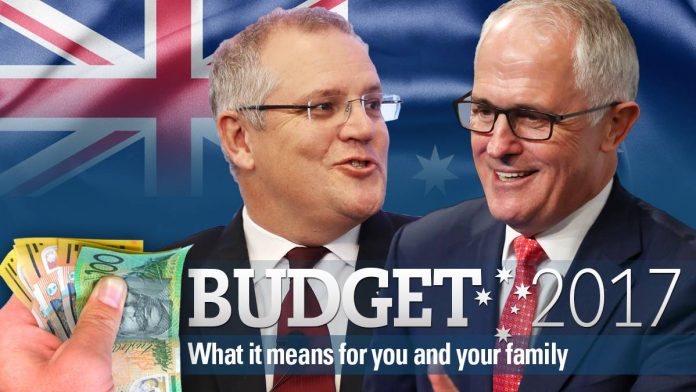
FEDERAL Treasurer Scott Morrison has handed down his second Budget, but how will it affect you?
Our five-minute guide gives you an overview of all you need to know.
THE ECONOMY
— The 2017-18 Budget deficit is $29.4 billion, forecast to drop to $21.4 billion in 2018-19, and then $2.5 billion in 2019-20, with expectation of a return to surplus of $7.4b by 20-21
— Unemployment is now expected to have peaked at the current rate of 5.75 per cent and will fall to 5.5 per cent in 2018-19, then to 5.25 per cent in 2020-21
— Inflation at 2 per cent this year and rising to 2.25 per cent next year, then 2.5 per cent in 2019-20 and through to 2020-21
— Total revenue $444.4 billion, up from $412.1 billion in 2016-17 and estimated to reach $476.1 billion in 2018-19
— Real GDP of 2.75 per cent, expected to rise to 3 per cent in 2018-19, where it will remain through to 2020-21
— Net debt to peak at 19.8 per cent of GDP in 2018-19, falling to 8.5 per cent in 2027-28
HOUSING/SUPERANNUATION
— First-home buyers to salary-sacrifice into their superannuation, taxed at a lower margin, to save for a home deposit
— Can contribute a total of $30,000 into their super, on top of compulsory contributions, or $15,000 per year
— Retired couples who downsize will be able to put $300,000 each into their superannuation, from the proceeds of their home sale
— A tax of $5000 per annum to be imposed on foreign investors with vacant properties
HEALTH
— Medicare rebates will rise from 2018 by around 50 cents
— Price of some medicines will fall
— $300 worth of extra dental care for children every two years
— Mental health funding for telehealth consultations, suicide prevention and research
— Families who refuse to vaccinate children will lose $28 a fortnight in family tax benefits.
EDUCATION
— University graduates to pay back student loans from a starting salary of $42,000 a year, down from $55,000
— Higher education fee contributions to be increased by 7.5 per cent, phased in over four years, from 2018
EARLY LEARNING AND CHILDCARE
– $2.5 billion more in early learning and child care, including the new system of fee subsidies
– $428 million for one-year extension to program guaranteeing 15 hours a week of preschool for four-year-olds.
– $61.8 million a year for indigenous and regional childcare services
– $5.9 million to develop new English language learning app for indigenous children (following success of foreign languages apps for preschoolers).
NDIS
The National Disability Insurance Scheme (NDIS) will be funded from 2019 by a half a percentage point rise in the Medicare Levy to 2.5% from 2% of taxable income.
This fills the $55.7 billion funding gap, the federal government’s contribution, for the scheme over the next ten years
WELFARE
— New Jobseeker Payment, which will consolidate seven existing income support payments
— $263 million allocated over four years to expand ParentsNext services, supporting parents of young children
— New measures to ensure benefits fulfil job seeking obligations
INFRASTRUCTURE

— $75 billion in infrastructure funding from 2017-18 to 2026-27
— Up to $5.3 billion committed for the Badgerys Creek Airport, commencing works in 2018.
— Government to deliver inland rail connecting Brisbane with Melbourne
— $1 billion infrastructure package for Victoria
— $1.6 billion for new Western Australian projects
DEFENCE
— Budget recommits troops for a further three years to overseas operations, notably the Middle East and the fight against Islamic State
— Various ADF bases to get upgrades and facelifts to cater for new hardware
— Military to play a $35 million role in the 2018 Gold Coast Commonwealth Games.
TOURISM
— Tourism Australia to have budget cut from $160 million to $148 million
— Extra $410 million in revenue flagged from linking visa application charges to annual CPI increases.
— Government to invest $185.4 million over four years from 2017-18 in significant reforms to Australia’s visa processing arrangements
SEXUAL ABUSE
— $33.4mm to establish a redress scheme for survivors of institutional child sex abuse
— Once scheme is live on July 1, 2018, survivors can claim up to $150,000 in compensation for abuse
—Will help 3000 victims who suffered abuse at hands of Commonwealth agencies including Defence, Immigration and Indigenous Affairs
PAID PARENTAL LEAVE
— Changes to the PPL scheme will be scrapped under a $17b saving for unlegislated policies, aka “zombie measures”
— Will mean 72,000 people won’t see a scaling back of payments and 7000 people who were due to have entire payment cut will now not suffer that fate.
HOMELESSNESS
— $381 million funding for homelessness services through to 2019-20, which is a major commitment to the sector as homelessness continues to rise.
— For the first time, states will now face sanctions from the Commonwealth if they don’t meet agreed homelessness targets.
FOREIGN AID
— Diplomats posted overseas to lose some of their salaries with a streamlining of allowances to save the government $37 million
SIN TAXES
— Cost of roll-your-own cigarettes and cigars to increase
— Will be taxed the same as manufactured cigarettes

